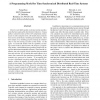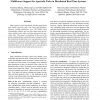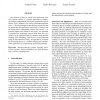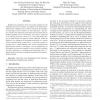105
Voted
RTAS
2007
IEEE
15 years 6 months ago
2007
IEEE
Discrete-event (DE) models are formal system specifications that have analyzable deterministic behaviors. Using a global, consistent notion of time, DE components communicate via...
105
click to vote
RTAS
2007
IEEE
15 years 6 months ago
2007
IEEE
Many mission-critical distributed real-time applications must handle aperiodic tasks with end-to-end deadlines. However, existing middleware (e.g., RT-CORBA) lacks schedulability ...
104
Voted
RTAS
2007
IEEE
15 years 6 months ago
2007
IEEE
The duration of time for which each application locks each shared resource is critically important in composing multiple independently-developed applications upon a shared “open...
114
click to vote
RTAS
2007
IEEE
15 years 6 months ago
2007
IEEE
Most of today’s real-time embedded systems consist of a heterogeneous mix of fully-programmable processors, fixed-function components or hardware accelerators, and partially-pr...
115
Voted
RTAS
2007
IEEE
15 years 6 months ago
2007
IEEE
This paper focuses on a technique to empower commercial-off-the-shelf (COTS) systems with an execution environment, and corresponding services, to support realtime and embedded ap...
112
Voted
RTAS
2007
IEEE
15 years 6 months ago
2007
IEEE
This paper discusses an approach for supporting soft realtime periodic tasks in Linux on performance asymmetric multicore platforms (AMPs). Such architectures consist of a large n...
115
click to vote
RTAS
2007
IEEE
15 years 6 months ago
2007
IEEE
Over the last thirty years, the MIL-STD 1553B data bus has been used in many embedded systems, like aircrafts, ships, missiles and satellites. However, the increasing number and c...
113
click to vote
RTAS
2007
IEEE
15 years 6 months ago
2007
IEEE
The prominent energy management technique in real-time embedded systems, Dynamic Voltage and Frequency Scaling (DVFS), was recently shown to have direct and adverse effects on sys...
138
click to vote
RTAS
2007
IEEE
15 years 6 months ago
2007
IEEE
Multiprocessor platforms have been widely adopted in both embedded and server systems. In addition to the performance improvement, multiprocessor systems could have the flexibili...
91
Voted
RTAS
2007
IEEE
15 years 6 months ago
2007
IEEE
Using preemption threshold scheduling (PTS) in a multi-threaded real-time embedded system reduces system preemptions and hence reduces run-time overhead while still ensuring real-...




